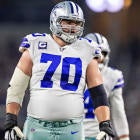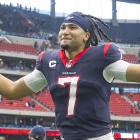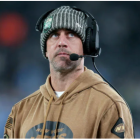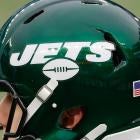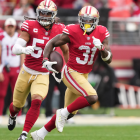A successful season in Dallas feels like a failure because of how it ended against the NFL's hottest quarterback and team, Aaron Rodgers and the Packers. The Packers won their eighth straight after Rodgers hit a miracle pass to Jared Cook in the waning seconds of Sunday's divisional playoff clash to set up the winning 51-yard field goal for a 34-31 win over the Cowboys.
The Cowboys have lost in the divisional round in their past four playoff appearances and haven't reached an NFC Championship since the 1995 season. Still, one loss shouldn't define the season. The Cowboys tied a franchise record with 13 regular-season wins and secured the NFC's top seed in the playoffs. The nine-win improvement is the biggest in the NFL from last season. Dallas also discovered that life after Tony Romo will not be bleak, thanks to Dak Prescott.
Here's a look at what's ahead for the Cowboys in the offseason.
What happens with Romo?
He would spend his entire NFL career with the Cowboys in a perfect world. But that's now impractical with Romo losing his nearly decade-long stranglehold on the starting quarterback job to Prescott, a 2016 fourth round pick, who took the job and ran with it after Romo was injured in the preseason.
Romo sounded like he still wanted to be an NFL starter in mid-November when he read a heartfelt statement conceding his job to Prescott to keep from being a distraction. He didn't show any rust leading the Cowboys to a touchdown in his lone drive against the Eagles during the regular-season finale, his first real game action since Week 12 in 2015.
Romo has the NFL's largest 2017 salary cap number at $24.7 million with a $14 million salary next season. He is scheduled to make $19.5 million and $20.5 million in 2018 and 2019, the final two years of his contract.
A salary of $14 million is unheard of for a backup quarterback. The average yearly salary for starting quarterbacks this season, including those on rookie contracts, is approximately $14.7 million, according to NFLPA data. Top backup quarterback money is currently $7 million to $7.5 million per year with incentives and salary escalators that could make a deal worth as much as $12 million per year. Romo taking a pay cut because he is making starting money seems remote because he doesn't want to be anybody's backup.
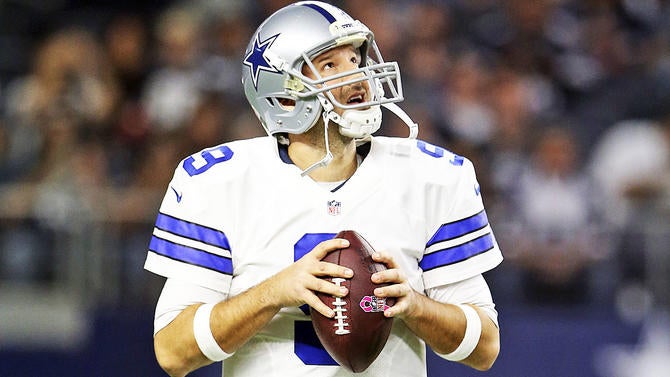
Trading Romo may not be easy. A robust trade market seems unlikely. Acquiring a quarterback with durability concerns who turns 37 in April doesn't make a lot of sense for teams in a complete rebuild, like the Browns and 49ers. Ready-made teams that are a quarterback away from being legitimate Super Bowl contenders, such as the Broncos and Texans, likely would have the most appeal to Romo. The optimal time to deal Romo is between the beginning of the start of the 2017 league year trading period on March 9 and prior to the conclusion of the 2017 NFL draft on April 29 before rosters have taken shape.
The Cowboys might not be able to get more than a mid-round draft pick for Romo because of his age and injury history, regardless of the timing. The Packers received a 2009 third-round pick from the Jets in a 2008 trade for a soon-to-be 39-year old Brett Favre, who was coming off of season in which he led Green Bay to the NFC Championship Game and was named an All-Pro.
Romo's preference would be for Dallas to release him so he can choose his next destination. A personal appeal to Cowboys owner Jerry Jones, with whom Romo has a special relationship, is the best chance of him getting his wish.
The Cowboys will have a $19.6 million salary cap charge for Romo if he is released or traded prior to June 2. That charge relates to the bonus proration in his 2013 extension and subsequent contract restructurings for cap purposes in 2014 and 2015. This cap charge for a player no longer on a team's roster is commonly referred to as dead money. $5.1 million of cap room would be gained immediately. Romo's cap numbers for 2018 and 2019 -- $25.2 million and $23.7 million -- would be wiped away once the roster move was made.
The cap hit would be taken over 2017 and 2018 with either one of these transactions occurring after June 1 or releasing Romo with a post-June 1 designation. NFL teams can release two players each year prior to June 1 that will be treated under the cap as if they were released after June 1. With a post-June 1 designation, a team is required to carry the player's full cap number until June 2 even though he is no longer is on the roster. The player's salary comes off the books at that time unless it is guaranteed. Dallas would have $10.7 million in dead money for 2017, which would free $14 million in cap space. Romo would remain on the Cowboys' books in 2018 with an $8.9 million cap charge.
Navigating the salary cap
The Cowboys have the most 2017 salary cap commitments in the NFL at almost $180 million using offseason accounting rules where only the top 51 cap numbers matter. That factors in cornerback Brandon Carr's contract voiding 23 days before the start of the 2017 league year on February 14. There's only $2.4 million of unused cap space carrying over from the 2016 league year.
The NFL's preliminary projections put the 2017 salary cap between $166 million and $170 million. Assuming the salary cap is set at $168 million, the Cowboys have approximately a $12.2 million overage once tenders for restricted free agents and exclusive rights players with expiring contracts, as well as the proven performance escalators for eligible 2014 draft picks, are taken into consideration. Carrying Romo next season at his $24.7 million salary wouldn't be prudent because cap space may be at a premium.
Dallas can eliminate the overage before it's required when the new league year begins on March 9 by engaging in an annual restructuring of contracts to free cap space, which pushes cap obligations into the future. The most likely candidates to restructure are tackle Tyron Smith, center Travis Frederick and star receiver Dez Bryant. Smith has a league high $15.8 million 2017 cap number for offensive tackles, while Frederick's $14.871 million 2017 cap hit leads centers by a good margin. Bryant's $17 million 2017 cap charge also is tops among wide receivers.
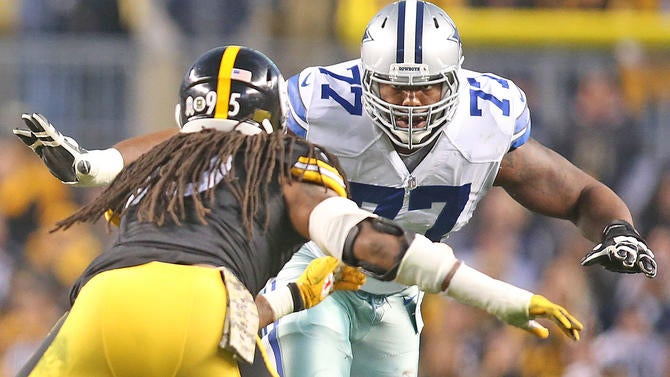
Smith has restructured his contract in each of the past two years. The Cowboys can create $7.38 million of cap room by converting the maximum $9.225 million of Smith's $10 million base salary into signing bonus. Frederick's six-year, $54.6 million preseason extension, which made him the NFL's highest-paid center, was designed with a restructure in mind because his fully guaranteed 2017 base salary is $14.221 million. Turning all but $775,000 of Frederick's base salary, his league minimum, into signing bonus will free up approximately $10.75 million of cap space.
These two moves alone would produce slightly more than $18.125 million of cap space to give the Cowboys a little breathing room. The Cowboys could also pick up slightly more than $8 million of cap room from a Bryant salary conversion where $12.1 million of his $13 million base salary becomes signing bonus.
Jason Witten has the NFL's biggest cap number in 2017 for tight ends at $12.262 million. It may make sense to explore a short-term extension for Witten, who is 34, along the lines of the two-year deal that Antonio Gates signed to remain with the Chargers in the offseason. Gates' deal averages $5.5 million per year. Witten is scheduled to make $7.4 million in 2017, which is his contract year. Getting Witten to agree to this type of deal where two new contract years are tacked on could create upward to $4 million of cap space depending upon how much of his existing salary gets converted to signing bonus and whether there's any increase in his 2017 compensation. The Steelers used this concept with Heath Miller in 2014 when he was in the twilight of his career to help with cap problems.
These moves and a quick resolution to Romo's situation wouldn't generate a major cap surplus compared to other NFL teams. The Cowboys likely wouldn't have more than $20 million in cap space at their disposal.
Free agency and team needs
The Cowboys have 18 unrestricted free agents, including major contributors in Carr and fellow cornerback Morris Claiborne, safeties Barry Church and J.J. Wilcox, defensive end Jack Crawford, guard Ronald Leary, and wide receivers Terrance Williams and Brice Butler.
The secondary, which surprisingly was a strength of the defense, could have a much different look next season because retaining Carr, Claiborne and Church could prove difficult. Claiborne finally started living up to the potential that made him the sixth overall pick in the 2012 draft before a groin injury sidelined him for the final nine regular-season games. Carr had his best season in Dallas since signing a five-year, $50.1 million deal in 2012, which required him taking a $3.6 million pay cut to $5.5 million last April to keep from getting released.
Williams didn't take advantage of his opportunity in 2015 to prove he was capable of being a No. 1 wide receiver when Bryant was hampered by foot and ankle injuries. Deals for No. 2 wideouts were mostly in the $6 million to $8 million range with $13 million to $20 million of guarantees during free agency last year.
Leary capitalized on La'el Collins missing most of the season with a right toe injury after asking for a trade in the offseason because he was slated to be a backup. Leary isn't expected back because of Collins' presence and right guard Zack Martin's potential contract extension, which should set a new salary standard for guards. It's conceivable that Leary could get a deal in the new second salary tier for guards on the open market in the $8 million per year neighborhood with $20 million in guarantees.
Martin's new deal will be in place before the 2017 season starts if the timing of the contracts for Frederick and Smith, who were also first-round picks, are any indication. Frederick and Smith received deals after only three NFL seasons making them the highest-paid players (by average yearly salary) at their positions. It's hard to imagine that Dallas won't do the same for Martin considering he is arguably the game's best guard, having earned three Pro Bowl selections in his three seasons. The Cowboys would prefer to stick with the league convention of left tackle sitting atop of the offensive line salary hierarchy where Smith's $12.2 million per year average from his 2014 extension serves as a ceiling for Martin. His overall guarantees should easily exceed Frederick's, which are slightly over $28 million, but may fall short of Smith's $40 million. Any deal Martin signs will need to be salary cap neutral in the first year with a huge spike in salary in the second year like Frederick's.
One area that should be addressed in free agency or the draft is the pass rush. 2015 second-round pick Randy Gregory struggled as a rookie. Most of this season was lost because of repeated violations of the NFL's substance abuse policy. Gregory recently was hit with another suspension under this policy, which will prevent him from playing for at least a year. According to Pro Football Focus, the Cowboys were last in pressuring opposing quarterbacks even though fourth quarter leads gave them plenty of late game pass-rushing opportunities.

Pass rushers are paid a premium on the open market. Olivier Vernon's five-year, $85 million contract with the Giants containing $52.5 million in guarantees is a benchmark for good free-agent pass rushers. Chargers outside linebacker Melvin Ingram, Giants defensive end Jason Pierre-Paul and Packers outside linebacker Nick Perry have expiring contracts. Whether any of these guys gets a comparable deal remains to be seen. The Cowboys' cap predicament will prevent paying significant money to a free-agent pass rusher unless the contract is structured like Carr's in 2012. He had a very low cap number in 2012, which jumped significantly in other years of the contract. Mario Addison would be a cheaper option. He had 9.5 sacks for the Panthers this season primarily as a situational pass rusher.
Outlook
Before Prescott had one of the best rookie quarterback seasons in league history, the Cowboys only went as far as Romo could take them. But the future is bright in Dallas because of Prescott and 2016 fourth overall pick Ezekiel Elliott, who easily won the NFL rushing title with more than 1,600 yards. A run at Eric Dickerson's single-season rushing record of 2,105 yards isn't out of the question for Elliott next season, provided the NFL's ongoing investigation of domestic violence accusations against him from an ex-girlfriend don't result in a personal conduct policy suspension. Prescott's best football also is ahead of him.
The key components of arguably the NFL's best offensive line should remain intact for the foreseeable future. All-Pros Smith and Frederick are under contract through the 2023 season. Martin won't be going anywhere either anytime soon once he signs his extension.
A calculated risk was made by taking Jaylon Smith, a top-five talent, in the second round of the 2016 draft. The playmaking linebacker missed his rookie season because of a severe knee injury he suffered in last season's Fiesta Bowl. If he can overcome the nerve damage from his injury, he should give the defense a big boost and could be one of the steals of that draft.
There has not been a repeat NFC East champion since the Eagles in 2004, but the Cowboys have a good chance to end the cycle. Dallas will be in the enviable position Seattle was in with Russell Wilson a couple of years ago once Romo's contract is off the books. There will be a one- or two-year window to amass talent with a low-paid quarterback because Prescott is under contract for another three seasons with $630,000 and $720,000 salaries in 2018 and 2019. It is incumbent upon Dallas to take advantage of their good fortune if they are going to consistently be Super Bowl contenders during Prescott's prime.










